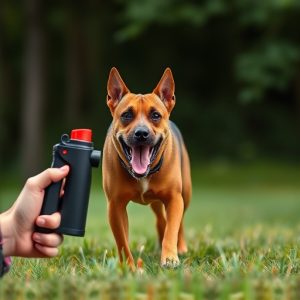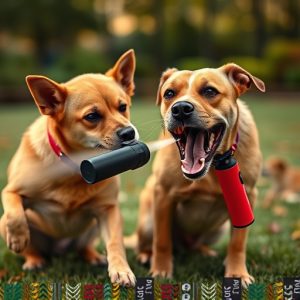Runner’s Guide: Safe Pepper Spray to Deter Dog Chases
Dogs often chase runners due to natural instincts, but specialized Safe Pepper Spray Strength for Do…….
Dogs often chase runners due to natural instincts, but specialized Safe Pepper Spray Strength for Dogs can deter these behaviors effectively. These sprays trigger dogs' aversion to irritants like capsaicin, causing temporary disorientation. Canine-specific formulations use lower concentrations, ensuring safety and responsible usage. When selecting a runner's dog deterrent spray, prioritize products designed specifically for canine safety, with reduced irritancy, low toxicity, balanced strength, and controlled release mechanisms. Training is crucial; familiarize your dog with the spray's scent through positive reinforcement, gradually increasing intensity in controlled environments to desensitize them. Apply the spray on the face or eyes during runs for maximum deterrence while minimizing harm.
“Enhance your outdoor runs with our comprehensive guide on runners’ dog deterrent spray protection. Discover why dogs chase runners and explore the science behind pepper spray as a safe yet effective deterrent. Learn how to choose the right Safe Pepper Spray Strength for Dogs tailored to your needs, along with practical training tips for optimal protection. Ensure your next run is hassle-free and enjoyable.”
- Understanding Dog Behavior and Why They Chase Runners
- The Science Behind Pepper Spray as a Deterrent
- Choosing the Right Safe Pepper Spray for Dogs
- Training and Implementation Tips for Effective Protection
Understanding Dog Behavior and Why They Chase Runners
Dogs, driven by their natural instincts, often chase runners due to a combination of factors. Their keen senses detect the swift movement and intriguing scent, triggering a pursuit that can be both playful and potentially hazardous for both the dog and the runner. Understanding these behaviors is crucial when considering effective protection methods.
While some dog owners may opt for training as a deterrent, others turn to safe pepper spray strength for dogs. These specialized sprays are designed with canine physiology in mind, ensuring minimal harm while deterring the chase instinct effectively. The key lies in selecting products formulated specifically for this purpose, guaranteeing both runner safety and animal welfare.
The Science Behind Pepper Spray as a Deterrent
The effectiveness of pepper spray as a deterrent for dogs is rooted in its ability to trigger their natural instinct to avoid irritants. Pepper spray, specifically formulated for canine use, contains capsaicin, the compound responsible for the burning sensation associated with chili peppers. When safe pepper spray strength for dogs is utilized, it stimulates sensory receptors in the eyes and nose, causing temporary disorientation and discomfort. This reaction is similar to when a dog encounters an unfamiliar scent or taste, leading them to avoid the source.
Unlike traditional pepper sprays used by law enforcement, which can be harmful to humans and pets if mishandled, canine-specific formulas are designed with safety in mind. These products typically have lower concentrations of capsaicin, ensuring minimal risk of prolonged irritation or adverse health effects. The key lies in finding a balance—strong enough to deter aggressive or curious dogs without causing excessive distress. This safe pepper spray strength allows runners and dog owners to protect themselves and their pets while promoting responsible usage.
Choosing the Right Safe Pepper Spray for Dogs
When selecting a runner’s dog deterrent spray, it’s paramount to choose a product designed specifically for canine safety. Not all pepper sprays are created equal; traditional law enforcement or military-grade options can be too potent and harmful to dogs. Look for safe pepper sprays formulated with canine safety in mind, ensuring they meet industry standards for reduced irritancy and low toxicity.
The strength of the spray should be balanced for effectiveness without causing excessive discomfort or injury. Opt for a can with a controlled release mechanism to prevent over-spraying and minimize the risk of accidental inhalation or eye contact. Additionally, consider sprays with natural ingredients or those approved by veterinary organizations, which can offer peace of mind that you’re using a safe and effective product for your canine companion during runs together.
Training and Implementation Tips for Effective Protection
When implementing runner’s dog deterrent spray, safety is paramount. Opting for a product with a safe pepper spray strength tailored for dogs is crucial to ensure minimal harm and effective deterrence. Many commercially available sprays are designed with dog safety in mind, using non-lethal ingredients that temporarily disrupt their sense of smell or vision without causing serious injury.
Training plays a significant role in the success of this method. Start by familiarizing your dog with the spray’s scent through positive reinforcement, rewarding calm behavior upon exposure. Gradually increase the intensity of the scent and practice in controlled environments to desensitize them. On actual runs, use the spray only when necessary, ensuring it’s directed towards the dog’s face or eyes for maximum impact while minimizing collateral damage. Regular practice and consistent application of this training will enhance your dog’s understanding of the deterrence, making outdoor runs safer for both parties.
Runners seeking protection from dog attacks can find a safe and effective solution in pepper spray designed specifically for canine deterrence. By understanding dog behavior and leveraging the science behind strong yet safe pepper spray, runners can defend themselves while minimizing harm to both parties. With proper training and implementation tips, this powerful tool can revolutionize outdoor runs, ensuring a safer experience for folks who love to hustle and bustle through their local landscapes. Remember that choosing the right safe pepper spray strength for dogs is key to effective protection.


